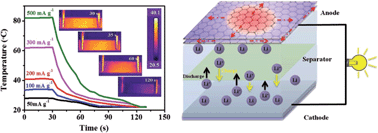A highly thermally conductive electrode for lithium ion batteries†
Abstract
A binder-free flexible graphene–SnO2 film electrode is readily obtained through filtration of electrochemically exfoliated graphene in Na2SnO3 electrolyte solution. Compared to the traditional polymer binder and carbon black formed electrode with the thermal conductivity usually lower than 2 W m−1 K−1, the binder-free graphene–SnO2 film electrode exhibits a greatly higher thermal conductivity of 535.3 W m−1 K−1, which is beneficial to heat dissipation for lithium ion batteries. The graphene–SnO2 film anode electrode also demonstrates a high capacity of 698.8 mA h g−1 at a current density of 200 mA g−1 even after 100 charge–discharge cycles.


 Please wait while we load your content...
Please wait while we load your content...